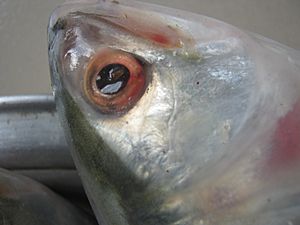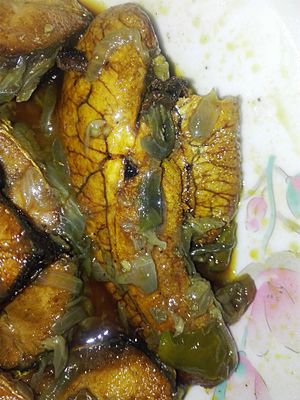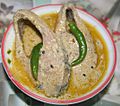Ilish facts for kids
Quick facts for kids Ilish, Hilsha Fish. |
|
|---|---|
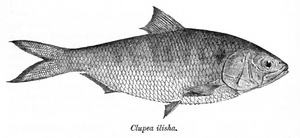 |
|
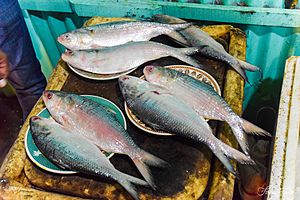 |
|
| Conservation status | |
| Scientific classification | |
| Genus: |
Tenualosa
|
| Species: |
ilisha
|
The Ilish (Tenualosa ilisha), also called Hilsa, is a type of fish related to herring. It's a very popular food fish, especially in countries like India and Bangladesh. This fish is so important that it's the national fish of Bangladesh and the state fish of West Bengal in India.
Most Ilish fish in the world (about 70-75%) come from Bangladesh. In 2017, Bangladesh officially recognized Ilish as its own special product. Many people in Bangladesh, around 450,000, earn their living by catching this fish. Millions more are involved in selling it.
Contents
What is the Ilish Fish Called?
The Ilish fish has many different names depending on where you are. Some common names include jatka, ellis, palla fish, and hilsha.
In India, people in Assamese, Bengali, and Odia communities also call it ilish. In Iraq, it's known as sboor. In Malaysia and Indonesia, it's often called terubok. In Myanmar, it's called ငါးသလောက် in Burmese.
Where Does the Ilish Live?
The Ilish fish lives in both salty ocean water and fresh river water. It can also be found in brackish water, which is a mix of salt and fresh water, like in estuaries. These fish can grow up to 60 centimeters (about 2 feet) long and weigh up to 3 kilograms (about 6.6 pounds).
You can find Ilish in rivers and estuaries in countries like Bangladesh, India, Pakistan, Myanmar, and around the Persian Gulf. This includes rivers like the Tigris and Euphrates in Iran and southern Iraq.
Ilish Life Cycle and Habits
Ilish fish are known for their special journey. They live in coastal ocean waters but travel up rivers to lay their eggs. This journey is called "anadromous." They usually swim about 50 to 100 kilometers (30 to 60 miles) upstream to spawn.
They mostly do this during the monsoon season, from June to September, and also from January to April. April is a very important month for Ilish breeding. Young Ilish fish, less than 9 inches long, are called "jatka" in Bangladesh. These young fish then return to the sea.
Where is Ilish Produced?
Ilish fish are found in 11 different countries. These include Bangladesh, India, Myanmar, Pakistan, Iran, Iraq, Kuwait, Bahrain, Indonesia, Malaysia, and Thailand.
Bangladesh catches the most Ilish in the world, about 86% of the total catch. Myanmar is second, and India is third. In Bangladesh, the Bhola District is known for catching the most Ilish. Thanks to efforts by the Bangladeshi government, the amount of Ilish caught there has increased a lot in recent years.
Why is Ilish a Popular Food?
Ilish is a very popular food, especially among people from Bengal and Odisha in South Asia. A famous dish is Bengali fish curry, often made with mustard oil. This dish is called Shorshe Ilish.
Ilish is popular in many parts of India, including West Bengal, Odisha, Tripura, Assam, Gujarat, and Andhra Pradesh. It is also sold to other countries around the world.
Ilish is an oily fish, which means it's rich in healthy fats called omega 3 fatty acids. These fats are good for your health.
People can cook Ilish in many ways, sometimes over 50 different ways! It can be smoked, fried, steamed, or baked. It's often cooked with mustard seed paste, yogurt, eggplant, and spices like cumin. The eggs of the Ilish fish, called roe, are also a popular side dish. Because the fish is naturally oily, it doesn't need much extra oil when cooked.
Ilish in Culture
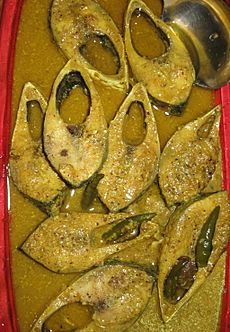
The Ilish fish is very important in the culture of many people, especially in Bengal and Odisha.
- In Andhra Pradesh, there's a saying that means "It's worth eating Pulasa (Ilish) even if you have to sell your wedding necklace." This shows how much people value this fish.
- In many Bengali Hindu families, two Ilish fish (called Jora Ilish) are bought for special religious days, like for the goddesses Saraswati or Lakshmi.
- Ilish is the national fish of Bangladesh.
- In Bengal, Ilish is sometimes given as a gift during weddings. The groom's family might give a pair of Ilish to the bride's family.
- In Bangladesh and West Bengal, Ilish is often called the 'Queen' of fishes. A popular meal during the monsoon season is 'khichudi' (a dish made with lentils and rice) served with fried Ilish.
- In Sindh, Pakistan, Ilish is called Pallo Machi and is a key part of Sindhi cuisine. It can be fried, cooked with onions and potatoes, or even barbecued. The fish's roe, called "aani," is also a special treat.
- In Kolkata, India, the rivalry between two football clubs, Eastbengal and Mohonbagan, is celebrated with food. When Eastbengal wins, fans cook an Ilish dish. When Mohonbagan wins, they prepare a prawn dish.
Overfishing and Protecting the Ilish
Because Ilish is so popular, too many are being caught. This is called overfishing. It means that very large Ilish fish, weighing 2 to 3 kilograms, are now rare. Even smaller fish are caught using very fine fishing nets. This has caused the price of Ilish to go up.
In the past, people used to avoid catching Ilish during their breeding season. However, as more people can afford the fish, these old traditions are sometimes forgotten. New fishing methods and pollution in rivers have made the problem worse.
Fishermen have been asked not to catch the young "jatka" fish so they can grow up and lay eggs. In Bangladesh, catching young jatka is now against the law. This ban helps protect the fish, but it also means some fishermen can't work for part of the year. There is also a black market where jatka are sold illegally.
Changes from global warming are also affecting where Ilish can breed, which further reduces their numbers. Protecting the Ilish is important for both the fish and the many people who depend on it.
Images for kids
-
Ilish Fry, an important part of Bengali cuisine.



